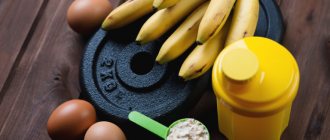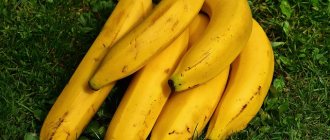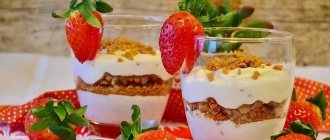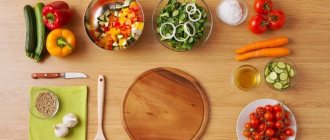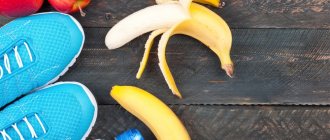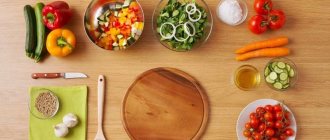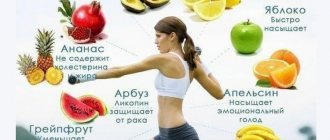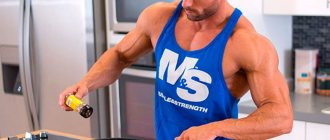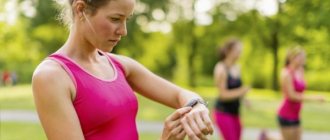CrossFit Nutrition Principles
The basis of nutrition is the ability to count calories and apply the data obtained as follows:
- To gain muscle mass, the process of anabolism must be started in the body . Anabolism is impossible without excess calories. We add 300-500 calories to the daily norm (taking into account physical activity).
- To maintain weight and improve physical performance during training, calorie intake should be slightly higher than the daily norm . You can improve your training performance without a significant calorie surplus, but the first option is more preferable.
- To burn fat and lose weight, we enter a state of catabolism . We subtract 300-500 calories from the daily norm (taking into account physical activity).
Calorie counting is the basis of CrossFitter nutrition.
Without understanding the rules listed above, an athlete may train for years and not be able to improve simply because he is in a catabolic state. He lacks energy to grow muscles and improve athletic performance. Conversely, CrossFit workouts for weight loss may not work if the athlete consumes too many calories.
Think Ahead - Health Support Supplements
It is not for nothing that doctors around the world focus on such a concept as prevention. This is the best approach to maintaining health and avoiding many problems. Taking into account the high intensity and increased loads in CrossFit, it is extremely important for athletes to take care of their health, because any injury, illness and other negative consequences are a significant setback in training.
Protection of joints and ligaments
When the time comes to evaluate the importance of these supplements, it is already too late. Simply put, this is what acts proactively and prevents you from encountering unpleasant diseases and injuries by training at full strength anytime, anywhere. Given the incredible workload, taking care of joints and ligaments is extremely important for athletes of any level, even beginners.
Black Magic Skull Dust
Price: 3584.00 rub.
Card Product
Controlled Labs Orange Health
Price: 3072.00 rub.
Card Product
Puritans Pride Hair, Skin & Nails Formula Type 1 and 3 Collagen
Price: 1350.00 rub.
Card Product
Go to the category Protection of joints and ligaments »
Test boosters for men
The effect of testosterone on the male body will always be much more powerful than any supplement, which is why athletes use any means to increase the level of this hormone. Complexes with plant extracts and natural ingredients that accelerate the natural production of testosterone in the body are best suited for this.
Killer Labz Terminator Test
Price: 3968.00 rub.
Card Product
Blackstone Labs Multi
Price: 2304.00 rub.
Card Product
Killer Labz LaxoBulk
Price: 3840.00 rub. 2592.00 rub.
Card Product
Go to the Testoboosters / PCT category »
There is great news for you! Now you don’t have to figure out all the variety of sports nutrition yourself! You can use our free service - selection of sports nutrition for your goals. To do this, read the article: “How to interact with a mentor to get maximum results, and even for free!” After reading, fill out the form for selecting sports nutrition.
The principle of well-being. Dietary restrictions
CrossFit isn't just about gaining muscle mass or losing weight. Nutrition in CrossFit should be based not only on objective, but also on the athlete’s subjective indicators.
A CrossFitter must eat in such a way that he can complete his training plan with maximum efficiency. If dietary restrictions prevent you from training, these restrictions are not needed.
Example: in 4 hours you need to do a workout. You forgot your lunch at home and you won’t get anything that a CrossFitter “can” eat anytime soon. Now you are at work and have no opportunity to change anything. Your work colleagues kindly treat you to a cake that you are “not allowed to eat” according to your diet. But in this case it is necessary to make an exception. You need energy to perform your workout. Sugary, junk food is not the best option for a CrossFitter. But it’s better to accept it than not eat at all.
Nutrition in CrossFit makes the athlete maximally charged for training. It is designed to create the correct hormonal background and the right motivation for training. In this regard, the following restrictions apply:
- Reduce your sugar intake to a minimum . Products with excess sugar content disrupt the motivation and reward system, the effective operation of which is necessary for full-fledged training. After eating sweets, CrossFitters note decreased physical and mental activity, increased feelings of laziness, apathy, and reluctance to work on themselves with 100% effort. Sugar is a natural drug that increases dopamine levels and reduces the sensitivity of dopamine receptors. Subjective life satisfaction increases. There is no motivation to work hard in training to lose weight, gain muscle mass, or tear apart opponents in competitions. The “athlete” ate too much cake and chocolate, and is now completely satisfied with life. CrossFit nutrition eliminates sugar from the diet for this very reason. Not for health benefits, but to increase motivation.
- Reduce your consumption of tasty, unhealthy, high-calorie foods. The mechanism is similar to the consumption of sugar. Many bodybuilders use the bulking phase as an opportunity for gut-fucking. If athletes who use pharmacology, thanks to this type of nutrition, gain impressive muscle mass, then “naturals” are content with fat without muscle. Overeating is an enemy not only for the motivation system, but also for testosterone. Overeating and high testosterone are incompatible. When a natural athlete decides to "bulk up" and eat 1000-2000 calories more than necessary, his testosterone drops to its lowest levels. During the “mass-gaining period” such an athlete can gain 15-20 kilograms of weight, where only 1-2 kilograms are muscles. The rest is fat.
- Avoid sudden weight fluctuations . Losing weight or gaining muscle mass is a gradual process. The body needs to adapt to new weight values. Especially during the period of muscle gain. CrossFit is an intense workout that forces the athlete's heart to work to its maximum. Normally it is safe and even useful. But with rapid growth, an untrained heart can put an end to an athlete’s career and life in general. Many strength athletes suffer from this.
Example: the volume of a novice athlete’s heart is 600 ml. Our newcomer weighs 60 kilograms. The heart does an excellent job of pumping blood through these 60 kilograms. Over the past 10 years, the test subject’s weight was 55-65 kilograms - almost unchanged. Suddenly, having learned about CrossFit and choosing the wrong diet for CrossFit, the beginner “goes on the masses.” He gains 20 kilograms and, while maintaining a similar heart volume, the first problems begin. Cholesterol levels rise, and the first alarming changes in the heart muscle occur. Then - “drying” up to 70 kilograms. For the first time in his life, our 27-year-old experimental subject had a heart ache. But he does not pay attention to this and again “sits on the mass.” From 70 kilograms, the weight increases to 90 in 9 months. With a heart volume of 600 ml, changes occur in the blood vessels, and the first diagnoses appear that precede fatal diseases. Another “drying” – the weight drops to 80 kilograms. The athlete's heart hurts more and more often. But we must continue. The goal is competition. Mass gain again - weight increases to 100 kilograms. Quick “drying” for competitions reduces weight to 90 kilograms.
Overload during competitions leads to irreversible changes in the heart muscle, which the athlete is not yet aware of. He returns home tired, 3 days later he returns to training and... suddenly falls. Heart attack. An ultrasound of the heart shows that our 30-year-old test subject has the heart of a 65-year-old man.
Sharp weight fluctuations and intense training against their background lies the cause of death for most bodybuilders, strength athletes and CrossFit followers. CrossFit nutrition is the exclusion of weight-cutting style cycling as described above.
Beta-alanine
If you know what CrossFit is, then you know what WOD is. These workouts are known for containing many high-intensity compound movements that create large amounts of metabolites, namely lactate (lactic acid) and hydrogen ions. Contrary to popular belief, it's not lactic acid that causes the "burn" in your muscles: it's the buildup of hydrogen ions, which can inhibit muscle contraction and lead to fatigue.
This is where beta-alanine comes in, helping to increase your body's stores of carnosine, which will help get rid of those extra hydrogen ions and improve your performance and training volume.4 Maybe that's all you need to crank out an extra round in your next AMRAP or mow a few seconds from the next Fran.
Recommended Dose : 3-6 g of beta-alanine per day, for at least 28 days, to maximize your ability to lose hydrogen ions.
Crossfit nutrition. Making up a diet
The basis of the diet for CrossFit is selected based on the following parameters:
- Individual preferences . Each athlete's taste preferences within a healthy diet may vary. Example: you read that to maintain good function you need to eat rice. Before this, you preferred buckwheat, but now, because of the information received, you refuse your favorite dish and choke on the hated rice. The result is problems with the gastrointestinal tract, deterioration in sports performance. Don't force yourself with food you don't like. There are many food options available as part of a healthy diet.
- Using the right products . The human body is evolutionarily adapted to certain foods. Example: we are more adapted to vegetables, fruits, lean meat (fish) and eggs than to cereals or cottage cheese. The body is more adapted to porridge and cottage cheese than to bread, potatoes or milk. We are better suited to potatoes and milk than to fast food. Take this hierarchy of foods into account when planning your diet.
- CrossFit nutrition is based on the correct balance of calories obtained from proteins, fats and carbohydrates . Acceptable proportions: 30-30-40, where 30% of energy comes from proteins and fats, and 40% of calories from carbohydrates; 25-25-50; 30-25-45;25-30-45;20-20;60. Unacceptable: 10-50-40 (most people eat this way); 40-50-10 (low energy from carbohydrates); 40-10-50 (low fat, without which the hormonal system suffers) and other similar proportions.
- Meal frequency and portion size . Use fractional meals. Fractional meals relieve the gastrointestinal tract and improve the athlete’s well-being during training. Fractional nutrition increases the percentage of absorbed nutrients and eliminates some health problems.
- Analyze your well-being . Avoid foods that make you feel worse, cause pain, or mental heaviness. Example: on the website Hvat.ru you learned that milk is the best product for gaining muscle mass. This is true, but your milk is simply not digested, resulting in problems with the gastrointestinal tract, and there is no result in weight gain. Analyze your feelings. In this example, give up milk.
BCAA
Whether you're a CrossFit athlete or not, it's smart to make branched-chain amino acids (BCAAs) part of your supplement stack. Flavored BCAAs mix damn well with boring water, which can help you stay hydrated throughout the day. Drinking BCAA before or during exercise can also speed up the recovery process.5-6
Of the three BCAAs, leucine is the most important for muscles. By stimulating protein synthesis and inhibiting protein breakdown, BCAA's help you recover from muscle damage during exercise. Taking them before exercise can reduce soreness and fatigue.
Recommended dose : 6-10 g before or during training. Eat foods that contain a leucine:isoleucine:valine ratio of 2:1:1
We recommend these BCAA:
CrossFit Products
Here is a list of crossfit nutrition products that should become the “base” in your diet:
#1 CrossFit product. Buckwheat
Buckwheat is the basis of the carbohydrate diet in the CrossFitter’s diet. Buckwheat porridge is a slow carbohydrate that supplies you with energy for a long time. Buckwheat is an excellent source of fiber and protein, the digestibility of which is only slightly lower than that of animal protein.
Buckwheat is a source of zinc, which the body needs to build the testosterone molecule, without which muscles do not grow.
It is a cheap source of carbohydrates. Carbohydrates from buckwheat porridge are cheaper than the same amount of energy from fast food or other unhealthy products.
Buckwheat porridge is a food that is beneficial for all body systems. Porridge is the basis of proper nutrition, which improves the functioning of the gastrointestinal tract, skin condition, and the functioning of all body systems.
This is a product that is suitable both for gaining muscle mass and for improving functionality or losing weight.
CrossFit Product #2. Milk
Milk is a cheap source of protein, fat and carbohydrates for CrossFitters. A liter of milk contains about 550 calories, which makes the white liquid an excellent mass-gaining product. Adding a liter of milk to the diet often solves the problem of “stagnation” in gaining muscle mass and weight gain.
Example: Your daily calorie intake is 2700 units. By consuming 2600-2800 calories on a consistent basis, your weight remains the same. No energy for muscle growth. Your CrossFit nutrition is not working. We add a liter of milk at night - instead of 2600-2800 we get 3150-3350 calories per day. By increasing the caloric intake of the diet, muscle mass begins to grow.
There is not enough liter of milk - add two. We get 1100 additional calories per day with high-quality protein, fat and carbohydrate composition, vitamins and minerals necessary for the effective functioning of the hormonal system.
Milk (kefir, fermented baked milk) is a product that can easily be used to regulate your diet. An ideal option for lazy people and lazy people.
Please note: not all people are lactose intolerant. Many people complain of feeling unwell after drinking milk. Your choice is lactose-free dairy products. Kefir, fermented baked milk, cottage cheese are an excellent option for replacing milk.
CrossFit Product #3. Eggs
Egg white is the most optimal source of protein for humans. Egg white is the standard of protein digestibility. The digestibility index of egg white is 100%.
No less useful is the “fat component” of eggs. Eggs contain healthy fats, as well as dietary cholesterol, without the consumption of which the condition of blood vessels improves, increases the risk of atherosclerosis, and disruptions in the hormonal system occur.
Consume eggs whole. Don't give up the yolk, which for decades has been considered a source of cardiovascular disease. Dietary cholesterol is good for blood vessels and good for the hormonal system!
CrossFit Product #4. Low glycemic index vegetables
It is difficult to single out one, the healthiest vegetable, since it does not exist. Vegetables are an ideal source of fiber, vitamins and slow carbohydrates. The lower the glycemic index of a product, the more suitable it is for CrossFit nutrition.
Consumption of vegetables and fiber is important from the point of view of gastrointestinal health, as well as in order to improve functionality by improving the health of the body with proper nutrition.
CrossFit Product #5. Chicken breast
Lean meat, to which our digestive system is best adapted. A source of quality animal protein.
Chicken fillet is an excellent product for both bulking and drying. This is one of the best sources of protein with which you can gain lean muscle mass or cut while losing a minimum of muscle mass.
CrossFit Product #6. Rice
The second most useful source of slow carbohydrates after buckwheat. Rice is not an alternative to buckwheat porridge, but a complement to it. Alternating slow carbohydrates from rice and buckwheat is a way to get maximum results in the shortest possible time. Rice is a source of vitamins and minerals, as well as a storehouse of vegetable protein with a unique amino acid profile.
For better absorption of protein from rice, it is worth eating rice together with animal products - eggs, meat, fish.
You can diversify your rice diet by using different varieties of rice.
Rice can be consumed with various spices that improve your health and increase testosterone levels (turmeric, for example).
Rice is a carbohydrate that can be given absolutely any flavor.
CrossFit nutrition in the carbohydrate part should be based on the use of vegetables, buckwheat and rice porridge.
CrossFit Product #7. Pollock
Lean fish is a source of:
- High quality animal proteins. Pollock is a fish that can replace chicken breast in your diet due to its mass-gaining properties.
- Unique amino acid profile. Fish complements the amino acid profile of any dish. The more diverse the amino acid profile of the protein consumed, the faster the muscles grow and the results in CrossFit improve.
- Savings. Lean fish is a cheap source of animal protein. Cheaper than meat.
Pollock is the most profitable type of fish in terms of quality protein-price-taste parameters. The taste of pollock can be changed using seasonings.
Any lean fish is an alternative to pollock.
CrossFit Product #8. red fish
A source of omega-3 fatty acids, without which the body cannot function properly. Red fish is a storehouse of omega-3s, healthy animal fats and proteins, without which progress in CrossFit will be slower than you want.
Red fish is a way to improve your health, improve your functionality, improve the condition of your cardiovascular system, skin, nails and hair.
Red fish is an expensive source of omega-3. A cheaper option is to take omega-3 supplements.
Red fish is also a source of protein, vitamins and minerals, the presence of which makes consuming red fish preferable to taking omega-3 supplements.
CrossFit Product #9. Pumpkin seeds
A source of healthy vegetable fats and calories.
An indispensable product for an athlete due to its content of fats, proteins, vitamins and minerals. Pumpkin seeds are beneficial for CrossFitters of both sexes, but are especially beneficial for men. High zinc content is an opportunity to increase testosterone levels and improve men's health.
The high content of magnesium, phosphorus, copper, manganese and other microelements and vitamins allows you to improve the general condition of the body, which will affect the fruitfulness of training.
It is important to combine sources of fatty acids. Without healthy fats (healthy ones - not trans fats), the hormonal system of men and women begins to malfunction, and therefore, without consuming high-quality animal and vegetable fats, long-term, fast, sustainable progress in CrossFit is impossible.
CrossFit Product #10. Fruits
Bananas, apples, citrus fruits, pears, peaches, grapes, and other fruits and berries are an indispensable addition to a CrossFitter’s diet.
With the help of fruits, you do not gain calories, but get vitamins, microelements, dietary fiber and taste sensations that make the CrossFitter's diet less bland.
It is advisable to include 2-3 fruits in your CrossFit diet on an ongoing basis.
Menu for CrossFitters for the week
| Monday | |
| First meal: | 50 grams of oatmeal or a serving of oatmeal, one small banana or a couple of pieces of cheese, a glass of kefir or cocoa. |
| Second meal: | Three hard-boiled eggs or a three-egg omelette, a small piece of fruit (green apple or orange). |
| Third meal: | Lean beef steak (150 grams) with green beans, fresh vegetable salad with herbs, green tea or coffee without sugar. |
| Snack: | 30-40 grams of dried fruits or nuts, one medium-sized orange. |
| Fourth meal: | 100 grams of white fish, vegetable salad with herbs and natural yogurt. |
| Snack before bed: | A glass (250 grams) of natural yogurt or kefir. |
| Tuesday | |
| First meal: | An omelette of three eggs or 50 grams of muesli with bran, one small fruit (banana, apple or pear), green tea or a glass of milk. |
| Second meal: | 100 grams of natural yogurt and a small portion of buckwheat porridge. |
| Third meal: | Chicken fillet (150 grams) with durum pasta and cheese, some fresh vegetables. |
| Snack: | 50 grams of dried fruit or a large fruit (banana, pear or apple). |
| Fourth meal: | 150 grams of fish, baked with vegetables, a portion of wild rice, a salad of fresh vegetables. |
| Snack before bed: | A glass of yogurt or 100 grams of cottage cheese. |
| Wednesday | |
| First meal: | Wheat or oatmeal, cocoa, a couple of pieces of cheese. |
| Second meal: | Two hard-boiled eggs, one small banana. |
| Third meal: | 150 grams of lean fish with buckwheat and green peas, a portion of fresh vegetable salad, a glass of kefir or milk. |
| Snack: | 100 grams of cottage cheese or a glass of natural yogurt. |
| Fourth meal: | Turkey fillet (150 grams) with zucchini and eggplants, baked in the oven, vegetable salad with herbs. |
| Snack before bed: | A glass of yogurt or milk. |
| Thursday | |
| First meal: | Three-egg omelette with seafood or canned tuna, a slice of whole grain bread, cocoa or green tea. |
| Second meal: | A sandwich of whole grain bread with cheese, a glass of milk. |
| Third meal: | Chicken fillet (150 grams) with mushrooms and onions, a portion of jacket potatoes, green tea. |
| Snack: | One banana or a handful of nuts (50 grams). |
| Fourth meal: | White fish (150 grams) with buckwheat, a portion of vegetable salad with herbs. |
| Snack before bed: | A glass of kefir or milk. |
| Friday | |
| First meal: | Buckwheat or oatmeal, a couple of pieces of cheese, cocoa. |
| Second meal: | Three-egg omelette or three hard-boiled eggs, a small piece of fruit (apple or pear). |
| Third meal: | Beef or pork steak (5.2911 ounces) with durum pasta, a serving of fresh vegetable and herb salad, green tea. |
| Snack: | A glass of natural yogurt or 100 grams of cottage cheese. |
| Fourth meal: | Chicken fillet (100 grams) with green beans and bell pepper, a portion of vegetable salad. |
| Snack before bed: | A glass of yogurt or kefir. |
| Saturday | |
| First meal: | Three egg omelette with cheese and a slice of whole grain bread, cocoa. |
| Second meal: | A serving of millet porridge with pumpkin, green tea. |
| Third meal: | 150 grams of lean white fish with baked potatoes or wild rice, a serving of fresh vegetable salad, green tea. |
| Snack: | A glass of natural yogurt or 100 grams of cottage cheese. |
| Fourth meal: | 150 grams of turkey fillet with green beans and buckwheat, a portion of fresh vegetable salad with herbs. |
| Snack before bed: | A glass of kefir or milk. |
| Sunday | |
| First meal: | Barley or wheat porridge, a couple of pieces of cheese, cocoa. |
| Second meal: | Three hard-boiled eggs, one small fruit (apple, pear or orange). |
| Third meal: | 150 grams of turkey fillet with buckwheat or durum pasta, a portion of fresh vegetable salad with herbs and natural yogurt. |
| Snack: | 50 grams of dried fruit or one small banana. |
| Fourth meal: | 150 grams of red fish with jacket potatoes, a portion of fresh vegetable salad with herbs. |
| Snack before bed: | A glass of milk or natural yogurt. |
Subscribe to our channel in Yandex.Zen!
https://justsport.info/nutrition/dieta-pri-trenirovkakh-po-metodu-krossfit https://cross.expert/zdorovoe-pitanie/crossfit-pitanie.html
Features of nutrition when losing weight and gaining muscle mass
The CrossFitter's diet also depends on the goal of the training. If an athlete wants to lose weight, especially for girls, food should contain an increased amount of protein (up to 30 g), while the consumption of complex carbohydrates should be reduced (up to 20 g), and fats should be reduced to a minimum.
Simple carbohydrates are excluded from the menu. You need to eat low-calorie foods rich in fiber. Meals should be frequent - up to 6 times a day, in small doses. When losing weight, it is not recommended to snack before and immediately after training.
If the athlete is faced with the task of gaining muscle mass, along with increased protein consumption (up to 30 g), it is necessary to increase the consumption of slow carbohydrates (up to 60 g). Fats cannot be completely eliminated from the diet. At the same time, you should consume only essential polyunsaturated fatty acids (up to 5 g). You need to eat high-calorie foods up to 6 times a day. When building muscle after training, it is imperative to “close” the anabolic window.
After training
Nutrition in CrossFit after training should be such that the body receives all the nutrients necessary for recovery. Carbohydrate foods help to restore strength faster, and protein is used as a building material for muscles.
After eating, you can allow yourself any amount of food. Of course, within reasonable limits. During recovery, the body will use every calorie, storing virtually nothing in fat reserves.
After intense physical activity, you should restore expended fluid reserves as quickly as possible. Water is necessary for every function in the body, including its restoration. Additionally, post-workout dehydration can cause headaches and a sluggish body.
